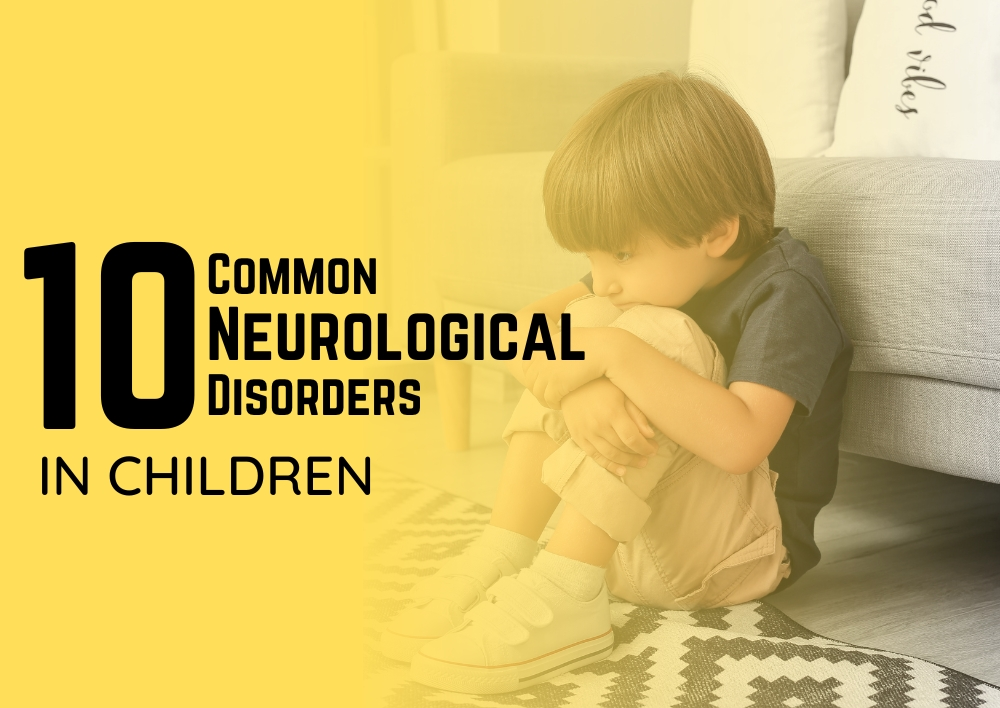10 Common Neurological Disorders in Children
Overview
The early years of a child's life are a period of rapid growth and development, during which the foundation for lifelong health is laid. Among the many aspects of a child's well-being, the development of the nervous system stands out as especially important. Comprising the brain, spinal cord, and nerves, the nervous system plays an important role in controlling bodily functions and promoting cognitive and motor skills. However, some children experience neurological disorders when abnormalities occur in the brain, nervous system, or muscle cells.
According to the renowned neurologist in Gurgaon at Miracles Apollo Cradle/Spectra, neurological disorders in children encompass a broad spectrum of conditions that affect the brain, spinal cord, and nerves, impacting various aspects of a child's development and daily life. These disorders cause unique challenges for both affected children and their families. In this blog post, we delve into the complexities of neurological disorders in children, exploring their causes, diagnosis, and potential treatments.
What are Neurological Disorders in Children?
Neurological brain disorders in children can affect the brain, spinal cord, and nerves, often manifesting in developmental, cognitive, behavioral, or physical abnormalities. These disorders can arise from various factors, including genetic predisposition, prenatal exposures, infections, traumatic injuries, and metabolic abnormalities.
10 Common Neurological Disorders in Children
Neurological disorders in children include many conditions that affect the brain, spinal cord, and nerves. These disorders can manifest in various ways, including developmental delays, seizures, movement disorders, and learning disabilities. Here is a list of common neurological disorders:
-
Autism Spectrum Disorder (ASD): Autism is a developmental disorder characterized by challenges in social interaction, communication, and repetitive behaviors. It generally appears in early childhood and can vary widely in severity and presentation.
-
Attention Deficit Hyperactivity Disorder (ADHD): ADHD is a neurodevelopmental disorder indicated by symptoms of inattention, hyperactivity, and impulsivity. It often starts in childhood and can last into adolescence and adulthood.
-
Cerebral Palsy (CP): Cerebral palsy is a group of movement disorders that appear in early childhood. It is caused by abnormal development or damage to the parts of the brain that control movement, balance, and posture.
-
Epilepsy and Seizures: Epilepsy is a neurological disorder characterized by recurrent seizures. Seizures are caused by abnormal electrical activity in the brain and can vary in severity and type.
-
Down Syndrome: This is a genetic disorder caused by the existence of an extra chromosome 21. Children with Down syndrome usually experience cognitive delays, and characteristic facial features, and may have specific medical conditions, such as heart defects and gastrointestinal issues.
-
Spina Bifida: Spina bifida is a congenital condition where the spinal cord and its surrounding structures do not develop properly. It can result in varying degrees of physical and neurological disabilities, depending on the severity and location of the spinal defect.
-
Muscular Dystrophy (MD): A muscular dystrophy is a group of genetic disorders characterized by progressive muscle weakness and degeneration. Duchenne muscular dystrophy (DMD) is one of the most common forms that affects children, primarily boys.
-
Dyslexia: It is a specific learning disability that affects both reading and language processing skills. Children with dyslexia may struggle with decoding words, spelling, and reading fluency despite having normal intelligence and adequate educational opportunities.
-
Pediatric Stroke: While less common than in adults, strokes can occur in children, leading to neurological deficits such as weakness, paralysis, speech difficulties, and cognitive impairments. Early recognition and intervention are critical for minimizing long-term effects.
-
Dyspraxia (Developmental Coordination Disorder): Dyspraxia is a neurological condition that affects movement and coordination. Children with dyspraxia may have difficulty with activities requiring fine or gross motor skills, such as writing, tying shoelaces, or playing sports.
Causes of Neurological Disorders
Neuro disorders in children can arise from a multitude of factors, both genetic and environmental. Understanding the various causes is important for diagnosis, treatment, and prevention efforts. Here are some common causes of neurological disorders in children:
-
Genetic Factors: Many neurological disorders have a genetic component, which means they can be inherited from one or both parents. Genetic mutations or abnormalities in specific genes can lead to conditions such as Down syndrome, Rett syndrome, muscular dystrophy, and neurofibromatosis.
-
Prenatal Factors: Events that occur during pregnancy can affect fetal brain development and increase the risk of neurological disorders. These factors include maternal infections (such as rubella or cytomegalovirus), exposure to toxins (such as alcohol or certain medications), maternal malnutrition, and complications during pregnancy or delivery.
-
Perinatal Factors: Conditions that occur around the time of birth can also contribute to neurological disorders in children. Perinatal factors include oxygen deprivation, trauma during birth, umbilical cord accidents, and infections acquired during delivery.
-
Postnatal Factors: Neurological disorders can also develop after birth due to various postnatal factors. These may include traumatic brain injuries, infections, exposure to toxins or environmental pollutants, nutritional deficiencies, and metabolic disorders.
-
Infections: Certain infections, both prenatal and postnatal, can directly affect the central nervous system and lead to neurological disorders in children. These infections include bacterial infections, viral infections, parasitic infections, and fungal infections.
-
Traumatic Injuries: Traumatic brain injuries resulting from accidents, falls, and sports-related injuries can cause neurological damage and lead to long-term effects, including cognitive impairments, motor deficits, and behavioral changes.
-
Autoimmune Disorders: In some cases, the body's immune system mistakenly attacks its tissues, including the nervous system, leading to autoimmune neurological disorders such as multiple sclerosis (MS), Guillain barre syndrome, and acute disseminated encephalomyelitis (ADEM).
-
Metabolic Disorders: Metabolic disorders involve abnormalities in biochemical processes that can affect the function of the nervous system. Examples include phenylketonuria (PKU), maple syrup urine disease (MSUD), and mitochondrial disorders.
-
Environmental Factors: Exposure to environmental toxins, pollutants, or substances during critical periods of brain development can increase the risk of neurological disorders. These may include lead, mercury, pesticides, air pollution, and certain industrial chemicals.
Symptoms of Neurological Disorders in Children
Symptoms of neurological disorders in children can vary widely depending on the specific condition, its severity, and the age of onset. These symptoms may affect various aspects of a child's development, including motor function, understanding, behavior, communication, and sensory processing. Here are some common symptoms that may indicate the presence of neurological problems in children:
-
Developmental Delays: Delayed achievement of developmental milestones, such as sitting up, crawling, walking, talking, or reaching cognitive milestones like understanding language or social cues.
-
Motor Deficits: Abnormalities in motor function, including muscle weakness, stiffness, floppiness, tremors, poor coordination, difficulties with balance and gait, and involuntary movements.
-
Seizures: Seizures are abnormal electrical disturbances in the brain that can manifest in various ways, including convulsions, staring spells, repetitive movements, altered consciousness, or sudden changes in behavior.
-
Intellectual Disabilities: Below-average intellectual functioning, characterized by difficulties with reasoning, problem-solving, memory, attention, and learning compared to peers of the same age.
-
Speech and Language Impairments: Difficulties with speech production, language comprehension, articulation, fluency, or expressive communication, which may manifest as delayed speech development, speech errors, or difficulties in expressing thoughts and ideas.
-
Sensory Processing Issues: Heightened or diminished sensitivity to sensory stimuli, including sounds, lights, textures, tastes, or smells, which may lead to sensory seeking or avoidance behaviors.
-
Behavioral Challenges: Behavioral problems such as impulsivity, hyperactivity, aggression, self-injurious behaviors, anxiety, depression, social withdrawal, obsessive-compulsive behaviors, or difficulties with emotional regulation.
-
Cognitive Impairments: Challenges with attention, memory, executive function (planning, organization, inhibition), problem-solving, or academic performance.
-
Communication Disorders: Difficulties in using or understanding language, including social use of language, speech sound disorders, language comprehension insufficiencies, or difficulties with nonverbal communication (gestures, facial expressions).
-
Neurological Deficits: Specific neurological deficits such as weakness or paralysis in one or more limbs, changes in muscle tone, abnormal reflexes, vision or hearing impairments, or loss of sensation.
Diagnosis of Neurological Disorders in Children
Diagnosing neurological disorders in children often requires a comprehensive evaluation that considers medical history, developmental milestones, neurological examination findings, and diagnostic tests. Pediatricians, neurologists, and other healthcare professionals collaborate to assess symptoms and determine the underlying cause of the child's condition.
-
Medical History: Gathering a detailed medical history helps identify any prenatal or perinatal factors, family history of neurological disorders, and past medical events that may be relevant to the child's current symptoms.
-
Developmental Assessment: Assessing developmental milestones provides valuable insights into a child's neurodevelopmental trajectory and helps identify any delays or regressions that may indicate an underlying neurological disorder.
-
Neurological Examination: A thorough neurological examination evaluates the child's cognitive function, motor skills, coordination, reflexes, and sensory responses, providing important clues to the nature and severity of their neurological condition.
-
Diagnostic Tests: Depending on the suspected diagnosis, various diagnostic tests may be used, including neuroimaging (such as MRI or CT scans), electroencephalography (EEG), genetic testing, metabolic screening, etc.
Treatment of Neurological Disorders in Children
Treatment Approaches for Neurological Disorders: The treatment of neurological disorders in children is highly individualized and may involve a combination of medical management, therapy, and supportive interventions. The goals of treatment typically focus on symptom management, optimizing function, and improving the quality of life for the child and their family.
-
Medications: Many neurological disorders in children can be managed with medication to control symptoms such as seizures, spasticity, or behavioral disturbances. Medications may need to be adjusted over time based on the child's response and any potential side effects.
-
Therapy: Different forms of therapy help in managing neurological disorders and promoting optimal development. These may include physiotherapy to improve motor function and mobility, occupational therapy to enhance daily living skills, speech therapy to address communication difficulties, and behavioral therapy to manage emotional and behavioral challenges.
-
Surgical Interventions: In some cases, surgical interventions may be necessary to treat neurological disorders, such as epilepsy surgery to remove epileptic foci or neurosurgical procedures to address structural abnormalities in the brain or spinal cord.
-
Supportive Services: Children with neurological disorders usually benefit from a range of supportive services, including special education programs, assistive devices, and access to community resources and support groups that cater to their specific needs.
Conclusion:
Understanding the common neurological conditions that affect children is important for early identification, intervention, and support. By raising awareness, and promoting inclusivity, we can empower children with neurological disorders to thrive and reach their full potential. Let's work together to create a supportive world for all children, regardless of their neurological differences.
Don't hesitate to reach out with your concerns or questions about your child's neurological health. Contact the top neurological specialist near you at Miracles Healthcare and take the first step towards promoting your child's well-being and maximizing their potential.














Was the information useful?
3 0